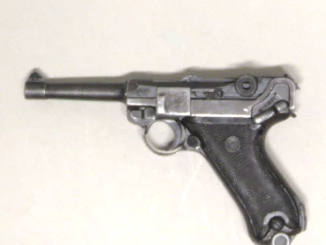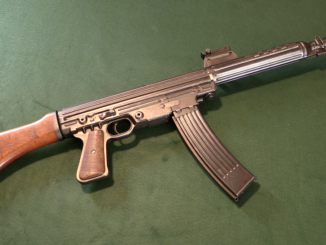After the failure of the domestic production Ahlberg pistols and some disappointment with the performance of surplus French Ruby pistols, the Finnish military turned to DWM in Germany for a main service pistol in 1922. The core of the Finnish armed forces had been exposed to the Luger as Jaegers in German military service during World War One, and they knew and liked the Luger design. Bowing to Versailles restrictions in the post-war years, the guns purchased were chambered for 7.65mm Luger, with sub-100mm barrels (specifically, 95mm and 98mm). The first 2,000 were received in 1922, another 2,000 in 1923, and by 1929 the Army had acquired 8,000 (purchases stopped in 1929 with the decision to produce a domestic pistol, which would be the Lahti L-35). The Luger in 7.65mm was designated the m/23 pistol.
In addition to Army purchases, many private individuals bought their own Lugers that would see military service, as did the Civil Guard. In fact, the Luger was a more common service pistol than the L-35 in both the Winter War and the Continuation War. Once the Winter War began, worn-out m/23 pistols were fitted with new 9x19mm barrels made by Sako and Tikkakoski, although the hot Finnish SMG ammunition would cause significant wear and eventually destroy many of the guns. Those that survived both wars would remain in service all the way into the 1980s, when they were finally surplussed.
One of the examples we have today is a gun that was eventually transferred to the Finnish prison administration system, and was marked by them – there was no crest or chamber marking put on the Finnish contract guns by DWM.




There seems to be a subtle difference between these two guns in the curve of the handle. The 7.65 looks to be deeper (?) or more rounded than the 9mm one to me. (The curve where the web of the hand would sit while the gun is in hand.)
I see on the one that was refitted with a 9mm barrel the tell-tale notch in the receiver in front of the chamber which seems to say this receiver was made for a Luger ARTILLERY (long barrel). The notch was required for the barrel-mounted adjustable sight to clear. This is probably not unusual, as DWM was using surplus WWI parts to build the post-war Lugers like the 1920 Commercial model (where ANYTHING is possible). Stands to reason the Finnish 1922 contract would draw on that stockpile of parts left over from WWI.
The Finnish 9 mm SMG ammo is hot indeed. It caused cracks in BDAs, too. The brass is something of the best to use if you reload your own 9 mm ammo. Ok, bulk 9 mm is so cheap that it isn’t worth to reload 9 mm currently, but if you desire to tailor a round that fits your particular gun like a fist in the eye, then the SMG brass is wonderful.
Tell me of this cheap bulk 9mm. Is it possible to learn this power?
It’s simple.
Use a high power primer.
Bullet and gunpowder can be left as normal.
Outside the US it is available …..
I could easily see Ian retiring to Finland someday.
Lol, he will be in his element, tired of Arizona sun 🙂
Stupid question: would the Luger’s specified “hot” cartridge loading help in keeping it from freezing up in cold weather? I haven’t heard any cases of Luger pistols jamming due to winter conditions…
May sound like plying with fashionable words hot-cool; in reality it relates to pressure more than anything.
Interestingly, as 7,65 mm Parabellum was common automatic pistol cartridge in Finland in 1920s, early SUOMI used them, thus resulting in crescent magazine, see 7,65 mm Suomi M/26: chapter here https://www.jaegerplatoon.net/MACHINEPISTOLS1.htm
“(…)purchases stopped in 1929 with the decision to produce a domestic pistol, which would be the Lahti L-35(…)”
Though in later of 1920s there were talks to start domestic production of Parabellum Pistole, they failed to yield production but provoked Major Arvo Ensio Saloranta to design Parabellum Pistole lookalike weapon, which remained only prototype
https://www.jaegerplatoon.net/ALMOST2.htm